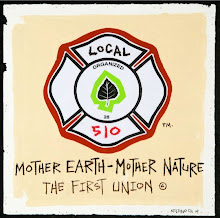Summer 2009: The New Economy, Thrift and Shift: 2 Ways to Prioritize the Economy
by Alisa Gravitz
As a nation, we now have the opportunity, as we did during the Great Depression and World War II, to reprioritize the economy. Simply put, we need to “thrift and shift.”
A clothing swap organized by a group of friends in Chicago last year involved 20-30 people. Leftover clothes were donated to a local charity. Photo by Erin Watson, torridly.org
We need to make thrift a fundamental value, to make conspicuous consumption a thing of the past, and return to the days when things were useful and made to last—to make reuse and repair “the new black.” We can use the crises of our time, both economic and environmental, as the impetus to shift our economic engine from the consumer sector to the new green-industrial sector.
My grandparents married during the Great Depression and started their family during World War II. My grandmother told me of those times with pride. Thrift was a necessity: She couldn’t buy a car or even nylon stockings. But she saved every bit of aluminum for the war effort, mended every piece of clothing several times over, and planted a victory garden. Though they had very little, when they could save a dime, she would get another 10-cent stamp toward a $25 war savings bond.
As tough as those times were, my grandmother felt that what she did every day mattered for the country. Families across the country changed their way of life nearly overnight to respond to a national crisis. Their actions provided resources for the war effort and helped keep food on the table in tough times.
Taken together, these actions gave the economy a whole new set of priorities—shifting from a failing consumer-based economy to an economy focused on providing for the country’s future.
As in my grandmother’s time, the consumer sector can no longer be the economy’s driver. The economic engine now needs to be a green-industrial effort. This time we won’t be building a war machine. We’ll be building economic activity, investment, and jobs for a sustainable future—from energy efficiency, mass transit, and sustainable agriculture to education, health, and fostering resilient communities—making sure no one is left behind.
Take the shift to green energy as an example of the size and scope of the green-industrial effort. Princeton University’s Carbon Mitigation Initiative says there’s still time to get the economic benefits and to prevent the worst crises of climate change. It will take at least 700 times more solar energy, 80 times more wind energy, improving the efficiency of existing buildings at least 25 percent, making new buildings net zero when it comes to using energy and water, and creating the infrastructure for it all. Green America’s Solar Catalyst study estimated the solar portion alone will create over a million jobs in the United States by 2020. Green energy jobs are good-paying jobs that can’t be outsourced.
Our country made an industrial shift of these proportions for World War II, and we can do it again. What we can’t do is go back to the way it was before the current meltdown. We need to create the fundamental system change that embeds new priorities—a new economics, with a new green engine, that provides well-being for all.
Alisa Gravitz wrote this article as part of The New Economy, the Summer 2009 issue of YES! Magazine. Alisa is executive director of Green America, a national organization advocating for a just and sustainable economy (www.greenamericatoday.org) and a board member of the Positive Futures Network, publisher of YES!. 
Friday, July 10, 2009
Promoting a New Economy- What are your thoughts?
Posted by
la fin du siècle
at
10:36 AM
![]()
Labels: A New Economy, from Returns to Money To Returns to Ones Own Labor
Subscribe to:
Post Comments (Atom)





























No comments:
Post a Comment